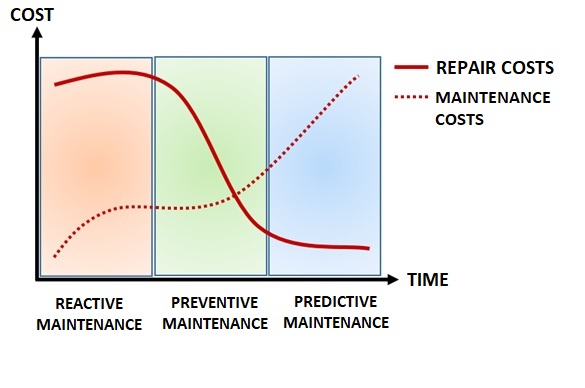Dynamic changes in the market, the need for constant competition among companies, the specter of crisis and the ever-increasing cost of living force entrepreneurs to manage their budgets flexibly. Speaking of industry, one of the most important challenges that must be addressed when looking for savings is the optimization of production costs. This is an extremely difficult and complicated process, because in practice it depends on the proper functioning of the machinery fleet, defined by the characteristics of technical condition, such as reliability, functionality, diagnosability and efficiency.
In the operation of machinery and equipment, it is necessary, first of all, to ensure their high availability and trouble-free operation with the possibility of avoiding unforeseen damage. To this end, it is necessary to properly organize the entire production process. One of the important factors affecting specific activities in this regard is the adoption of an appropriate maintenance strategy.
REACTIVE MAINTENANCE
The initial model of maintenance strategy was reactive maintenance, which involves taking corrective action after a failure occurs. The reactive approach also includes correcting machine operation based on apparent malfunctions. With this approach, only records are kept on machines, spare parts and their inventories, in order to efficiently replace the needed part when a failure occurs. However, this approach does not analyze the average operating time of machines, their efficiency, the number of downtimes and other operational indicators. It is reasonable to conclude that reactive maintenance is operating machines until they break down without a specific strategy. Consequently, this leads to a decrease in the efficiency of the work process of both machines and equipment, as well as employees, an increase in the cost of rectifying failures and mistakes that have occurred, employee conflicts, and even a decrease in work safety!
PREVENTIVE MAINTENANCE
In view of the observed consequences of the lack of implementation of a well-considered fleet operation strategy, the preventive maintenance model was introduced. This is a strategy of carrying out regular and planned intentional maintenance events, understood as: inspections, overhauls and maintenance, the purpose of which is to eliminate the occurrence of unintentional events (faults, damage, failures). The difference in approach also lies in the collection of documentation and information necessary to analyze the technical condition of the machinery park.
Preventive activities performed by the Maintenance Service include:
- Identifying the scope and resources of inspection, maintenance and repair work,
- Preparing and updating schedules for periodic inspections of machinery and equipment,
- Inspection and correction of technical and operational documentation, Performing operational work in the form of inspections, maintenance, service, overhaul and repair,
- The safe and efficient removal of any malfunctions that occur in the operation of machinery and equipment, and the rectification of breakdowns,
- Analysis of the situations that have occurred and the work that has been done,
- Taking care of the completeness and accuracy of the documentation collected.
PREDICTIVE MAINTENANCE
With the development of the Industry 4.0 concept (More on Industry 4.0, in the next article), new solutions have developed to increase the efficiency of machines and equipment in use and minimize unplanned downtime. Modern systems for predicting failures are based on Artificial Intelligence (AI) and Machine Learning technologies, among others. Activities based on observation of processes and the technical condition of machines using modern technologies are called predictive maintenance. The main advantage of this strategy is the ability to take action before a failure occurs, which significantly reduces the costs that would have to be incurred to restore the machine to a fit state. In addition, carrying out predictive actions extends the life of machines and ensures the continuity of their operation.
REAL COSTS
Despite the numerous negative consequences of reactive maintenance, low maintenance cost is often cited as its main advantage. With no need to implement the system, no record-keeping and no maintenance and repair work, there are no costs in the initial phase. Preventive and predictive strategies require greater expenditures, both financial and labor, at the very beginning of their implementation. However, it is worth remembering that the cost of unpredictable faults or failures can exceed the cost of servicing the machinery fleet in general.
The more advanced the strategy, the greater the effort and finances. In order to apply predictive measures, it is necessary to constantly monitor the technical condition of machines in order to forecast further states. Thus, it is necessary to implement systems and integrated sensors to analyze the parameters of the machinery fleet, but this, is associated with a high financial outlay.
The preventive approach, on the other hand, generates costs for cyclical maintenance and overhaul of machines, regardless of whether they are needed at any given time. In the end, therefore, it is more expensive and involves more resources.
The optimal solution seems to be the possibility of combining both solutions and using a hybrid strategy.
An effective solution for implementing a hybrid strategy and leading to improved production efficiency is a CMMS system. Such systems support the process of carrying out inspections, maintenance and repairs of the machinery park, as well as improving the collection of necessary technical documentation. Ultimately, a CMMS class system is an investment that leads to minimization of work and cost savings.


